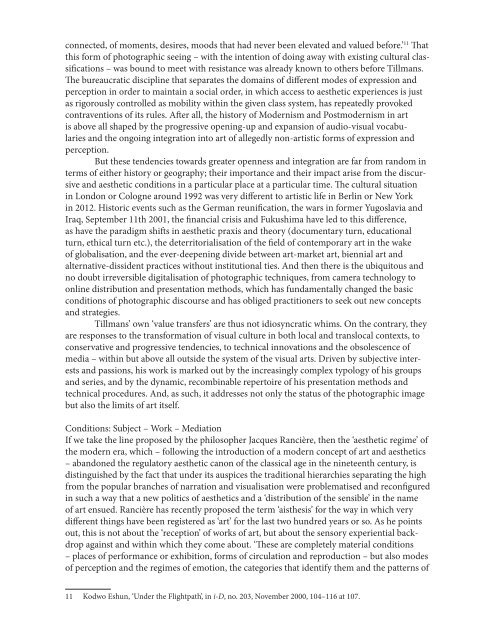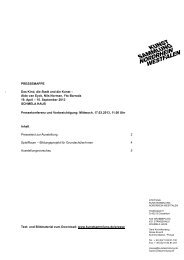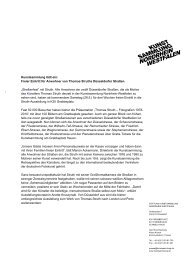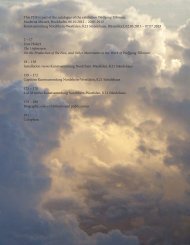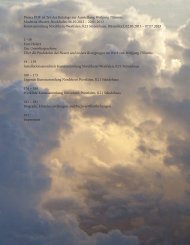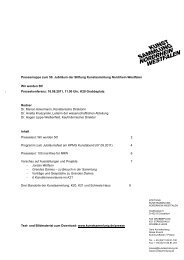Download online catalog (pdf)
Download online catalog (pdf)
Download online catalog (pdf)
Create successful ePaper yourself
Turn your PDF publications into a flip-book with our unique Google optimized e-Paper software.
connected, of moments, desires, moods that had never been elevated and valued before.’ 11 That<br />
this form of photographic seeing – with the intention of doing away with existing cultural classifications<br />
– was bound to meet with resistance was already known to others before Tillmans.<br />
The bureaucratic discipline that separates the domains of different modes of expression and<br />
perception in order to maintain a social order, in which access to aesthetic experiences is just<br />
as rigorously controlled as mobility within the given class system, has repeatedly provoked<br />
contraventions of its rules. After all, the history of Modernism and Postmodernism in art<br />
is above all shaped by the progressive opening-up and expansion of audio-visual vocabularies<br />
and the ongoing integration into art of allegedly non-artistic forms of expression and<br />
perception.<br />
But these tendencies towards greater openness and integration are far from random in<br />
terms of either history or geography; their importance and their impact arise from the discursive<br />
and aesthetic conditions in a particular place at a particular time. The cultural situation<br />
in London or Cologne around 1992 was very different to artistic life in Berlin or New York<br />
in 2012. Historic events such as the German reunification, the wars in former Yugoslavia and<br />
Iraq, September 11th 2001, the financial crisis and Fukushima have led to this difference,<br />
as have the paradigm shifts in aesthetic praxis and theory (documentary turn, educational<br />
turn, ethical turn etc.), the deterritorialisation of the field of contemporary art in the wake<br />
of globalisation, and the ever-deepening divide between art-market art, biennial art and<br />
alternative-dissident practices without institutional ties. And then there is the ubiquitous and<br />
no doubt irreversible digitalisation of photographic techniques, from camera technology to<br />
<strong>online</strong> distribution and presentation methods, which has fundamentally changed the basic<br />
conditions of photographic discourse and has obliged practitioners to seek out new concepts<br />
and strategies.<br />
Tillmans’ own ‘value transfers’ are thus not idiosyncratic whims. On the contrary, they<br />
are responses to the transformation of visual culture in both local and translocal contexts, to<br />
conservative and progressive tendencies, to technical innovations and the obsolescence of<br />
media – within but above all outside the system of the visual arts. Driven by subjective interests<br />
and passions, his work is marked out by the increasingly complex typology of his groups<br />
and series, and by the dynamic, recombinable repertoire of his presentation methods and<br />
technical procedures. And, as such, it addresses not only the status of the photographic image<br />
but also the limits of art itself.<br />
Conditions: Subject – Work – Mediation<br />
If we take the line proposed by the philosopher Jacques Rancière, then the ‘aesthetic regime’ of<br />
the modern era, which – following the introduction of a modern concept of art and aesthetics<br />
– abandoned the regulatory aesthetic canon of the classical age in the nineteenth century, is<br />
distinguished by the fact that under its auspices the traditional hierarchies separating the high<br />
from the popular branches of narration and visualisation were problematised and reconfigured<br />
in such a way that a new politics of aesthetics and a ‘distribution of the sensible’ in the name<br />
of art ensued. Rancière has recently proposed the term ‘aisthesis’ for the way in which very<br />
different things have been registered as ‘art’ for the last two hundred years or so. As he points<br />
out, this is not about the ‘reception’ of works of art, but about the sensory experiential backdrop<br />
against and within which they come about. ‘These are completely material conditions<br />
– places of performance or exhibition, forms of circulation and reproduction – but also modes<br />
of perception and the regimes of emotion, the categories that identify them and the patterns of<br />
11 Kodwo Eshun, ‘Under the Flightpath’, in i-D, no. 203, November 2000, 104–116 at 107.


